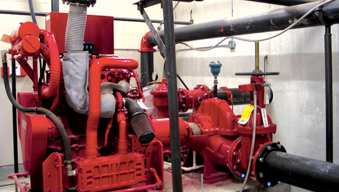Regarding fire protection systems, fire pumps play a vital role in ensuring the safety of a building and its occupants. These pumps are designed to enhance water pressure when the existing source isn't sufficient for firefighting purposes. However, once a fire protection system is installed and handed over to the building owner, more is needed to assume that the fire pump will continue to perform flawlessly. Regular inspection, testing, and maintenance (ITM) are imperative to keep these systems in peak condition.
The Purpose of the No-Flow Test:
The no-flow test, often called a churn test, is an essential component of fire pump ITM. This test simulates a situation where the fire pump is activated but not required to deliver water. Its primary objectives are to:
- Verify the pump's readiness to start promptly in an emergency.
- Prevent overheating of the pump during extended operation.
- Identify any abnormal conditions or malfunctions that may compromise the pump's performance.
Frequency of No-Flow Tests:
The frequency of no-flow tests depends on the type of fire pump in place. Diesel fire pumps typically require weekly churn tests. On the other hand, electric fire pumps can undergo these tests every month, with certain exceptions and risk analysis considerations. Specific scenarios such as limited service controllers, vertical turbine fire pumps, or those drawing water from insufficient sources necessitate weekly churn tests.
Key Steps in a No-Flow Test:
A no-flow test involves several critical steps to ensure the fire pump's reliability. These steps include:
- Starting the pump automatically to simulate a pressure drop in the system.
- Running the electric pump for a minimum of 10 minutes or the diesel pump for a minimum of 30 minutes.
- Having qualified personnel present during the test.
- Monitoring the operation of relief valves to prevent overheating.
- Conducting visual observations before and during the test.
- Recording pressure gauge readings and other essential data.
- Making necessary adjustments and inspections to ensure optimal performance.
Why No-Flow Tests Are Crucial:
No-flow tests are an integral part of maintaining fire pumps for several reasons:
Reliability in Emergencies: These tests ensure that the fire pump will start when needed, without hesitation. In a fire emergency, every second counts, and a reliable pump can make the difference in controlling a blaze.
Prevention of Overheating: Overheating can damage the pump and compromise its performance. The no-flow test allows for the early detection of overheating issues, preventing costly repairs and downtime.
Early Issue Identification: By conducting visual observations and recording data during the test, potential problems can be identified and corrected before they escalate into major malfunctions.
Compliance with Standards: Regular no-flow tests ensure compliance with NFPA 25, the standard for ITM of water-based fire protection systems. Compliance not only guarantees safety but also satisfies regulatory requirements.
Regular testing and maintenance of fire pumps, including weekly or monthly no-flow tests, are essential to ensure the continued functionality and reliability of these critical components of fire protection systems. These tests are key to verifying the readiness of fire pumps to perform when called upon in the event of a fire, preventing overheating, and identifying potential issues before they become critical. By adhering to these testing and maintenance practices, building owners can protect their investments and, more importantly, safeguard lives and property in the event of a fire.















